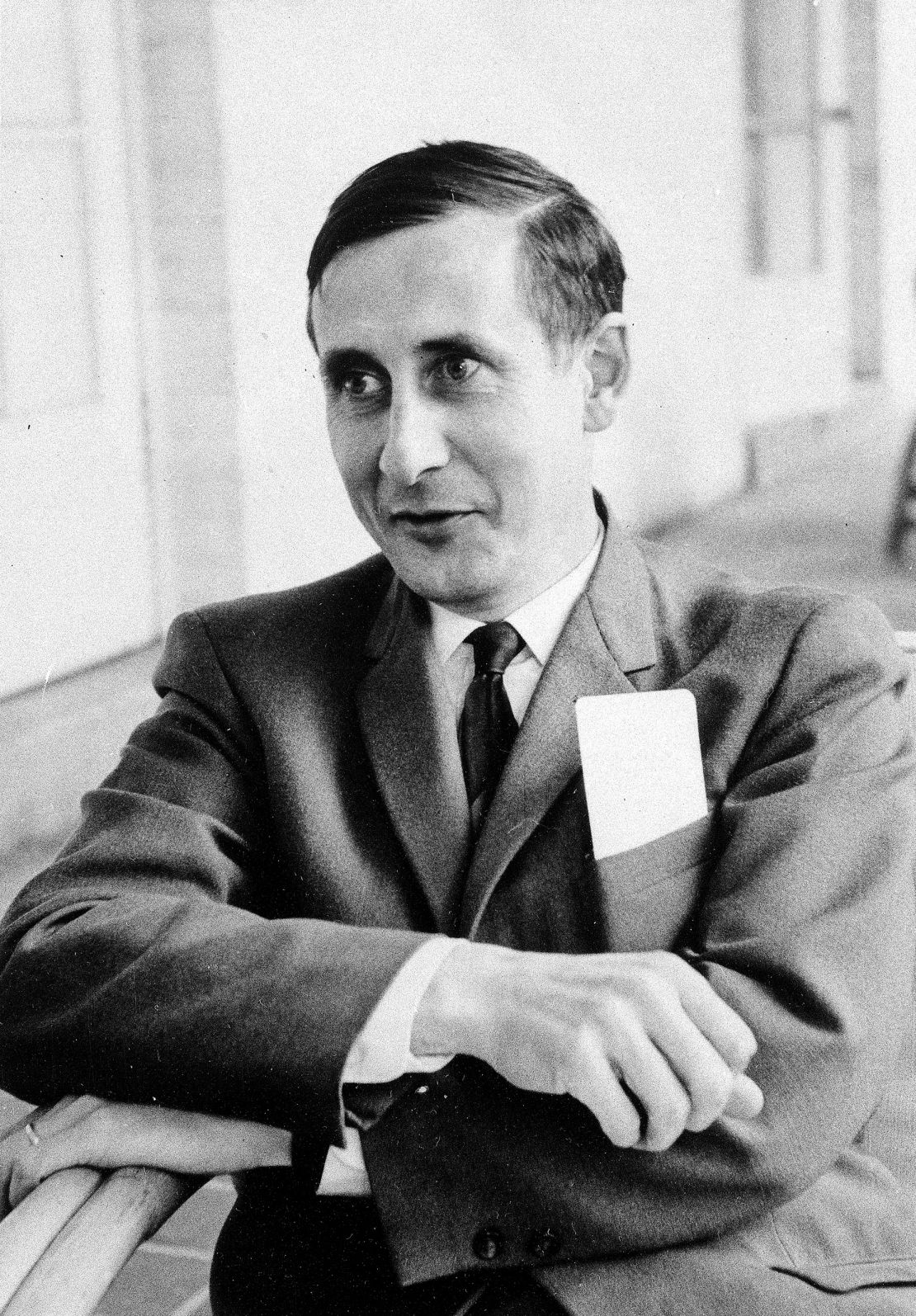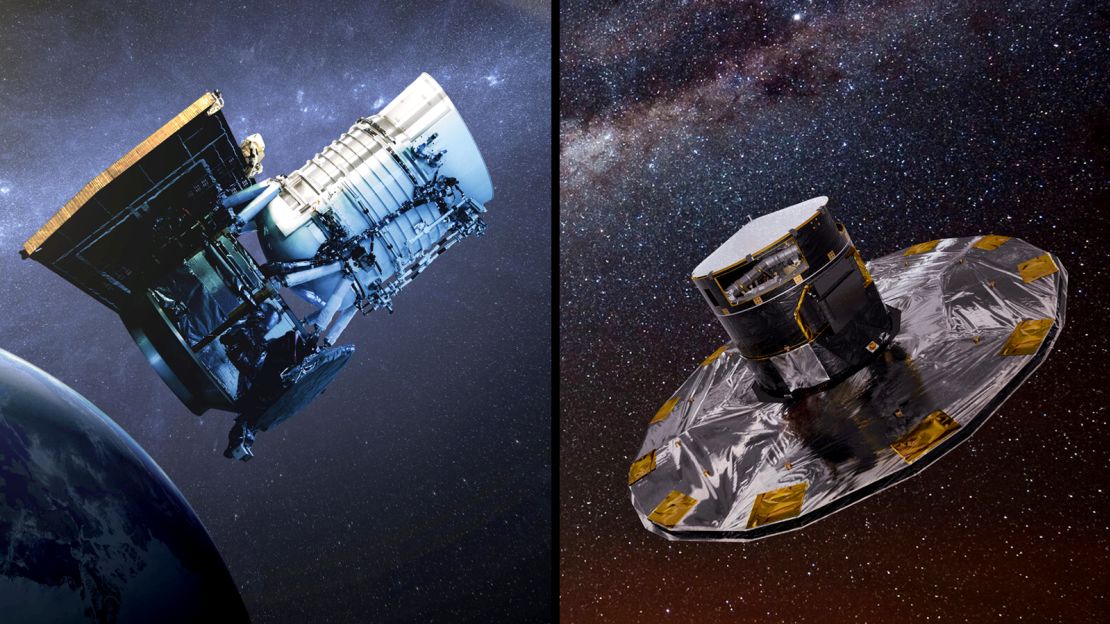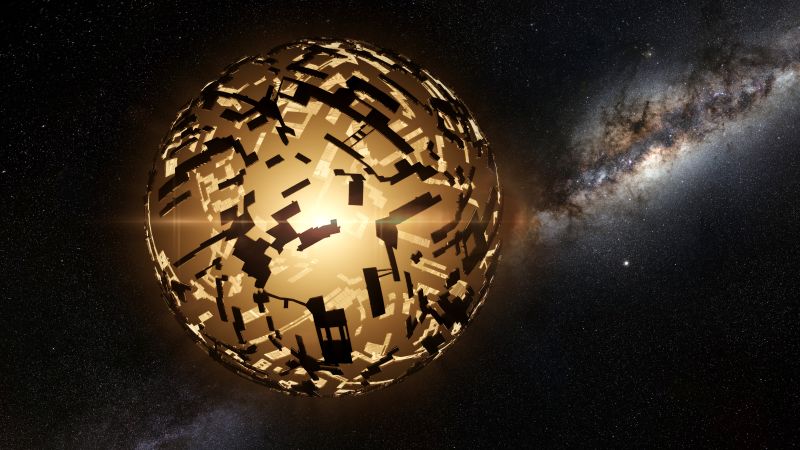Sign up for CNN’s Wonder Theory science newsletter. Explore the universe with news on fascinating discoveries, scientific advancements and more.
CNN
—
What would be the ultimate solution to the energy problems of an advanced civilization? Renowned British American physicist Freeman Dyson theorized it would be a shell made up of mirrors or solar panels that completely surrounds a star — harnessing all the energy it produces.
“One should expect that, within a few thousand years of its entering the stage of industrial development, any intelligent species should be found occupying an artificial biosphere which completely surrounds its parent star,” wrote Dyson in a 1960 paper in which he first explained the concept.
If it sounds like science fiction, that’s because it is: Dyson took the idea from Olaf Stapledon’s 1937 novel “Star Maker,” and he was always open about that. The late scientist was a professor emeritus at the Institute of Advanced Study in Princeton, New Jersey.
Still, coming from a thinker who some in the scientific community say might have been worthy of a Nobel Prize early in his career, the concept took hold and the hypothetical megastructures became known as Dyson spheres, even though the physicist later clarified that they would actually consist of “a loose collection or swarm of objects traveling on independent orbits around the star.”
In his paper, Dyson also noted that Dyson spheres would give off waste heat detectable as infrared radiation, and suggested that looking for that byproduct would be a viable method for searching for extraterrestrial life. However, he added that infrared radiation by itself would not necessarily mean extraterrestrial intelligence, and that one of the strongest reasons for searching for such sources was that new types of natural astronomical objects might be discovered.
“Scientists (at the time) were largely receptive, not to the likelihood that alien civilisations would be found to exist, but that a search for waste heat would be a good place to look,” said George Dyson, a technology writer and author and the second of Dyson’s six children, via email. “Science fiction, from ‘Footfall’ to ‘Star Trek,’ took the idea and ran with it, while social critics adopted the Dyson sphere as a vehicle for questioning the wisdom of unlimited technological growth.”
The elder Dyson himself argued, “It would be much more rewarding to search directly for intelligence, but technology is the only thing we have any chance of seeing.”

In the 1960s, there was no way to actually search for Dyson spheres, but in more recent times many researchers have looked for them, including those at the SETI Institute, a nonprofit organization with a mission to search for extraterrestrial intelligence, and Fermi National Accelerator Laboratory, known as Fermilab. Now, a new study that looked at 5 million stars in the Milky Way galaxy suggests that seven candidates could potentially be hosting Dyson spheres — a finding that’s attracting scrutiny and alternate theories.
The authors of the study, published May 6 in the journal Monthly Notices of the Royal Astronomical Society, specifically set out to search for Dyson spheres, in the form of infrared heat near stars that couldn’t be explained in any other way.
Using historical data from telescopes that pick up infrared signatures, the research team looked at stars located within less than 1,000 light-years from Earth: “We started with a sample of 5 million stars, and we applied filters to try to get rid of as much data contamination as possible,” said lead study author Matías Suazo, a doctoral student in the department of physics and astronomy of Uppsala University in Sweden.
“So far, we have seven sources that we know are glowing in the infrared but we don’t know why, so they stand out.”
There is no conclusive evidence that the seven stars have Dyson spheres around them, Suazo cautioned.
“It’s difficult for us to find an explanation for these sources, because we don’t have enough data to prove what is the real cause of the infrared glow,” he said. “They could be Dyson spheres, because they behave like our models predict, but they could be something else as well.”
Among the natural causes that could explain the infrared glow are an unlucky alignment in the observation, with a galaxy in the background overlapping with the star, planetary collisions creating debris, or the fact that the stars may be young and therefore still surrounded by disks of hot debris from which planets would later form.

The data used by the researchers comes from two active space telescopes — the Wide-field Infrared Survey Explorer, or WISE, from NASA and Gaia from the European Space Agency — as well as an astronomical survey of the sky in infrared light called The Two Micron All Sky Survey. Also known as 2MASS, the collaboration between the University of Massachusetts and the US space agency’s Jet Propulsion Laboratory took place between 1997 and 2001.
The candidate stars are all red dwarfs, the most common type of star in our galaxy. They are also dimmer and smaller than our sun, which makes follow-up observations more difficult. It’s unclear at this point whether the stars have planets around them, as they haven’t been observed yet by any of the telescopes that could potentially spot orbiting planets. However, many of the thousands of exoplanets scientists have identified so far orbit red dwarfs, which makes their presence likely; planets orbiting red dwarfs have a higher chance of being inhabitable, according to NASA.
An earlier study, published in March and using data from the same sources as the new report, had also found infrared anomalies among a sample dataset of 5 million stars in our galaxy.
“We got 53 candidates for anomalies that cannot be well explained, but can’t say that all of them are Dyson sphere candidates, because that’s not what we are specifically looking for,” said Gabriella Contardo, a postdoctoral research fellow at the International School for Advanced Studies in Trieste, Italy, who led the earlier study. She added that she plans to check the candidates against Suazo’s model to see how many tie into it.
“You need to eliminate all other hypotheses and explanations before saying that they could be a Dyson sphere,” she added. “To do so you need to also rule out that it’s not some kind of debris disk, or some kind of planetary collision, and that also pushes the science forward in other fields of astronomy — so it’s a win-win.”
Both Contardo and Suazo agree that more research is needed on the data, and that ultimately they could turn to NASA’s James Webb Space Telescope for more information, as it is powerful enough to observe the candidate stars directly. However, because of the lengthy, competitive procedures that regulate use of the telescope, securing access might take some time.
If Dyson spheres really exist, what could they be used for? “If you picture ourselves having as much energy as the sun is providing every second, we could do unheard of things,” Suazo said. “We could do interstellar travel, maybe we could even move the entire solar system to our preferred location, if we wanted.”
But don’t hold your breath, because the technology and the raw materials required to build the hypothetical structures are far beyond humanity’s grasp.
“They are so big that everything we have on Earth would not be enough to build them,” Suazo added. “Freeman Dyson said that we should dismantle Jupiter — the whole planet (for the raw materials).”
That supercolossal scale probably means that Dyson spheres, if they exist at all, are very rare.
“The importance of this work is that it provides the first strong evidence that there are not a lot of Dyson Spheres in our galaxy, contrary to the expectations of some that they might be an inevitable end-state of technological species’ expansion out into their solar systems,” said study coauthor Jason Wright, a professor of astronomy and astrophysics at Penn State University, via email.
“The candidates Matías (Suazo) has found are important because whatever they are — and they are likely stars surrounded by material from some sort of rare event, like a planetary collision, although they could be Dyson spheres — they are rare and interesting objects worthy of further study, for instance by the James Webb Space Telescope.”
Dyson died in 2020 before any of his spheres could be found — although they are just one of a dozen ideas that bear his name.
“As a young scientist, Dyson showed that three competing quantum theories were actually the same theory — he summarily ended the competition,” said William Press, the Leslie Surginer Professor of Computer Science and Integrative Biology at the University of Texas at Austin. He was not involved in the study. “Later, he applied his genius to areas of astronomy, cosmology, the extraterrestrial realm, and also the very real problem of nuclear proliferation here on planet Earth. At the time of his death, he was recognized as a provocative and creative thinker.”
George Dyson also attested to his father’s fascination and comprehensive reach across disciplines.
“Taking advantage of a short attention span and an aversion to bureaucracy, he contributed to five fields of mathematics and eleven fields of physics, as well as to theoretical biology, engineering, operations research, literature, and public affairs,” the younger Dyson said. “Many of his ideas were controversial, with one of his guiding principles being that ‘It is better to be wrong than to be vague.’”
The approach of the researchers behind the new study could offer a more fruitful path in the search for extraterrestrial intelligence, said Tomotsugu Goto, an associate professor of astronomy at the National Tsing Hua University in Taiwan. He also was not involved with the study.
“However, contamination by circumstellar debris disks, which mimic Dyson Sphere infrared signatures, remains a concern,” he added in an email. “Authors argue that the debris disks around (dwarf stars) are rare, but the 7 candidate authors selected out of 5 million sources are also rare. Despite this, the seven candidates warrant further investigation with powerful telescopes for a more definitive evaluation.”
A May 23 paper published in response to the one by Suazo and his colleagues suggests that at least three of the seven stars have been “misidentified” as Dyson spheres and could instead be “hot DOGs” — hot dust-obscured galaxies — and that the remaining four could probably be explained this way as well.
Because Suazo’s study touches on the fundamental question of whether humankind is alone in the universe, the search for Dyson candidates straddles different fields — including basic sciences, philosophy and religion — and might therefore increase the involvement of young scientists and the interest of the scientific world in the topic, according to Zaza Osmanov, an affiliate of SETI and associate dean of the School of Physics at the Free University of Tbilisi in Georgia, who also was not involved with the research.
However, he added, the radiation fingerprint of the seven Dyson sphere candidates might be explained by natural phenomena as well. “The hypothesis of the artificial origin of any, even very interesting, radiation, should be the last springboard when all possible natural explanations are exhausted,” Osmanov said. “And for this, future research is necessary.”
As for Dyson himself, if he were still alive, he also would be highly skeptical that these observations represent a technological signature, his son George argued: “But the discovery of new, non-technological astronomical phenomena is exactly why he thought we should go out and look.”

